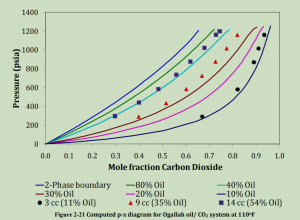Near-Miscible CO2 Application to Improve Oil Recovery
本研究探讨了在低于最小混溶压力(MMP)条件下,近混溶CO2注入提高石油采收率的可行性,并旨在通过实验工作和油藏模拟来加深对近混溶CO2驱油机理的理解。研究关注的压差范围是0.8 MMP至MMP。以堪萨斯州的Arbuckle地层为例,展示了在近混溶条件下评估CO2注入的方法。实验室实验包括相态行为研究、岩心流动测试和使用CMG软件包构建相态行为模型。
CMG软件的应用情况
CMG软件包中的WinProp软件被用来构建相态行为模型。该模型基于Peng-Robinson方程状态(EOS),需要输入每个组分的关键属性,如临界压力、临界温度、偏心率和组分间的交互系数,以执行相平衡计算。研究中还调整了EOS参数,以便模型能够复现实验室测定的油藏属性和观察到的油/CO2相互作用。此外,使用CMG软件包中的GEM软件构建了一维Compositional模型,以模拟Slim Tube实验,并与实验结果进行比较。
Abstract
Carbon dioxide (CO2) injection for enhanced oil recovery is a proven technology. CO2 injection is normally operated at a pressure above the minimum miscibility pressure (MMP), which is determined by crude oil composition and reservoir conditions. This is the lowest pressure at which the injected CO2 becomes dynamically miscible with the crude oil remaining in the reservoir. However, many reservoirs are located at depths or under geologic conditions such that they must operate at pressures below the MMP. When CO2 is injected at below the MMP, displacement efficiency decreases as a result of the loss of miscibility. CO2 injection is usually not considered as an enhanced oil recovery process in these reservoirs. Near miscible displacement generally refers to the process that occurs at pressures slightly below the MMP, but the actual pressure range has never been clearly defined.
The objectives of this study were to investigate the feasibility of near-miscible CO2 application and improve our understanding of the mechanisms of near-miscible CO2 flooding by conducting appropriate experimental work and reservoir simulation. The pressure range of interest was from 0.8 MMP to MMP in our study. The Arbuckle formation of Kansas was used as an example to demonstrate our approach to evaluate CO2 flooding at near-miscible conditions. The suite of laboratory experiments used to evaluate the feasibility of operating at pressures below MMP for Arbuckle reservoirs included phase behavior studies, core flow tests and phase behavior model construction using CMG software package.
Phase behavior studies were carried out to characterize the near miscible conditions. Slim tube displacements and swelling/extraction tests were performed to identify the near miscible range and the mass transfer mechanisms which were responsible for the oil recovery within this range. A phase behavior model was constructed and well-tuned to simulate oil properties, CO2/crude oil interactions and slim tube results. Core flow tests were conducted to evaluate the oil recovery efficiency in the near miscible range.
Initial laboratory works indicated that miscibility was not achievable, however at least 65% to 80% of the waterflood residual oil for dolomite cores and lesser from 45% to 60 % for sandstone core in the near-miscible region was observed. The principal oil recovery mechanism in the near-miscible range appeared to be extraction/vaporization of hydrocarbon components from crude oil into the CO2 rich vapor phase, coupled with enhanced mobility control due to the reduction of oil viscosity. This suggested that application of carbon dioxide in the field would require injection and recycling of large volumes of carbon dioxide. Further study is needed to determine if such a process is economically feasible. However the prospect of recovering up to 1 billion barrels of oil from Arbuckle reservoirs offers significant economic potential.
作者单位
作者Ly Huong Bui提交给堪萨斯大学化学与石油工程研究生学位项目和研究生院,以部分满足获得科学硕士学位的要求。


